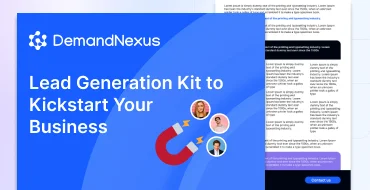Account-based marketing (ABM) flips the traditional sales funnel, focusing on high-value accounts with personalized campaigns. To prove its worth and optimize performance, tracking the right ABM metrics is essential. Unlike broad
lead generation or content marketing, ABM demands a tailored scorecard that measures engagement, pipeline progress, and revenue impact. This in-depth guide explores key ABM metrics, KPIs, and reporting strategies, with insights on tools like HubSpot and LinkedIn, plus a case study showcasing how
DemandNexus drives measurable results.
Why ABM Metrics Matter
ABM metrics provide a clear lens into the effectiveness of your
account-based marketing strategy. They help you:
- Prove ROI to stakeholders by tying campaigns to revenue.
- Identify high-performing tactics for optimization.
- Align sales and marketing around shared goals.
- Refine targeting to focus on accounts with the highest potential.
Unlike traditional marketing, which often prioritizes lead volume, ABM focuses on quality engagement with specific accounts. A well-crafted ABM scorecard tracks progress across the
ABM funnel, from initial outreach to long-term advocacy.

ABM Metrics vs. Traditional Marketing Metrics
ABM metrics differ significantly from those used in traditional
funnel marketing. Here’s a comparison:
| Aspect |
ABM Metrics |
Traditional Metrics |
| Focus |
Account-specific engagement and revenue |
Lead volume and broad conversions |
| Key KPIs |
Engagement, pipeline influence, deal velocity |
Impressions, click-through rates, MQLs |
| Funnel |
Flipped, account-centric |
Linear, lead-centric |
| Channels |
Personalized (LinkedIn, email) |
Broad (SEO, social media) |
ABM metrics prioritize depth over breadth, measuring the impact of targeted campaigns on high-value accounts rather than casting a wide net.
Key ABM Metrics to Track
A robust ABM scorecard tracks metrics across the funnel, from engagement to revenue. Here are the most critical
ABM funnel metrics to monitor:
1. Number of Target Accounts
Measure the total accounts in your ABM program, segmented by tiers (1:1, 1:Few, 1:Many). This ensures you’re targeting accounts that align with your Ideal Customer Profile (ICP). Use tools like HubSpot to track account lists and enrich data with intent signals.
2. Target Account Engagement
Gauge how actively accounts interact with your brand. Track metrics like:
- Website visits from target accounts (via reverse-IP mapping).
- Email opens and replies from cold email outreach.
- Content downloads (e.g., whitepapers, case studies).
- Event or webinar registrations.
High engagement signals interest, guiding your
lead nurturing efforts.
3. Social Media Engagement
Monitor interactions on platforms like LinkedIn, where B2B decision-makers are active. Key metrics include:
- Ad impressions and click-through rates for LinkedIn campaigns.
- Post interactions (likes, comments, shares).
- Page visits from social referrals.
These metrics reveal how effectively your content marketing resonates with target accounts.
4. Sales Velocity
Sales velocity measures how quickly accounts move through the ABM funnel. Calculate it as:
Time from opportunity creation to close
Faster velocity indicates efficient campaigns, often driven by personalized content and aligned sales efforts.
5. Form Completions
Track how many target accounts complete forms (e.g., demo requests, content downloads). This middle-of-funnel metric shows content resonance and intent to engage further. HubSpot’s form analytics can pinpoint which assets drive completions.
6. Meetings Booked
Count the number of meetings scheduled and attended with target accounts. This bottom-of-funnel KPI reflects the success of your nurturing and outreach, such as
lead research-driven campaigns.
7. Conversion Rate
Measure the percentage of target accounts that convert to customers:
(Closed-Won Deals / Total Opportunities) * 100
Break it down by channel (e.g., LinkedIn vs. email) to identify high-performing tactics.
8. Average Deal Size
Calculate the average contract value (ACV) of ABM-driven deals. Larger deal sizes justify the investment in personalized campaigns, a hallmark of ABM’s focus on high-value accounts.
9. Pipeline Influence
Track the revenue attributed to ABM campaigns within your sales pipeline. This KPI links marketing efforts directly to business outcomes, critical for stakeholder buy-in.
10. Revenue Won
Measure total revenue generated from ABM accounts, including initial sales, upsells, and renewals. HubSpot reports revenue won as the top ABM metric, reflecting its direct impact on the bottom line.
11. Upsells and Cross-Sells
Monitor additional revenue from existing ABM accounts through upsells or cross-sells. Strong relationships built via ABM often lead to higher customer lifetime value (CLV).
12. Churn Rate
Calculate the percentage of ABM accounts that don’t renew:
(Lost Accounts / Total Accounts) * 100
Low churn indicates successful retention, a key goal of ABM’s long-term relationship focus.
Building an ABM Scorecard
An ABM scorecard organizes these metrics into a cohesive reporting framework. Here’s how to create one:
- Define Goals: Align metrics with objectives (e.g., revenue growth, faster sales cycles).
- Select KPIs: Choose metrics like engagement, conversion rate, and revenue won.
- Use Tools: Leverage HubSpot or Salesforce for real-time tracking and visualization.
- Segment Data: Break down metrics by account tier or channel (e.g., LinkedIn campaigns).
- Review Regularly: Analyze weekly or monthly to identify trends and optimize.
A scorecard ensures your
ABM strategy remains data-driven, with clear insights for stakeholders.
Case Study: DemandNexus Boosts ABM Performance for a SaaS Company
A mid-sized SaaS company offering data analytics tools struggled to measure the impact of its ABM campaigns, with unclear KPIs leading to misaligned efforts.
DemandNexus stepped in to overhaul their metrics strategy.
- Challenge: Low visibility into campaign performance, with only 15% of target accounts engaging.
- Solution: DemandNexus implemented a tailored ABM scorecard using HubSpot, tracking engagement, sales velocity, and revenue won. They optimized LinkedIn ads and cold email campaigns based on engagement data, focusing on high-intent accounts.
- Results: Engagement rates rose to 60%, conversion rates improved by 25%, and revenue from ABM accounts grew by 30% in six months.
DemandNexus’s data-driven approach, leveraging advanced metrics and tools, helps B2B companies maximize ABM ROI. Their services can refine your scorecard and boost campaign performance.
Tools for Tracking ABM Metrics
Effective ABM reporting relies on robust tools. Here are key platforms to consider:
| Tool |
Purpose |
Example |
| CRM |
Track account interactions and pipeline |
HubSpot |
| Social Analytics |
Monitor LinkedIn engagement |
LinkedIn Sales Navigator |
| ABM Platform |
Measure account-specific KPIs |
Terminus |
Optimizing Your ABM Strategy with Metrics
Use ABM metrics to refine your
marketing strategy:
- Low Engagement: Test new content formats or channels, like personalized LinkedIn InMail.
- Slow Sales Velocity: Streamline outreach with targeted demos or case studies.
- High Churn: Enhance post-sale support to boost retention.
A/B testing, supported by tools like HubSpot, helps identify high-performing tactics for continuous improvement.
Your ABM Metrics Playbook
Tracking ABM metrics transforms your B2B strategy from guesswork to precision. Build a scorecard that captures engagement, pipeline influence, and revenue, using tools like HubSpot and LinkedIn to monitor performance. Regularly analyze data to optimize campaigns and prove ROI. With a data-driven approach, your ABM funnel can drive high-value conversions and long-term growth. Ready to elevate your ABM game?
DemandNexus offers expert metrics solutions to power your B2B campaigns. Contact them today to unlock actionable insights.





